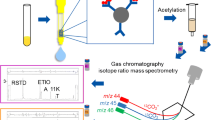Abstract
Tetracosactide (Synacthen), a synthetic analogue of adrenocorticotropic hormone (ACTH), can be used as a doping agent to increase the secretion of glucocorticoids by adrenal glands. The only published method for anti-doping control of this drug in plasma relies on purification by immunoaffinity chromatography and LC/MS/MS analysis. Its limit of detection is 300 pg/mL, which corresponds to the peak value observed 12 h after 1 mg Synacthen IM administration. We report here a more sensitive method based on preparation of plasma by cation exchange chromatography and solid-phase extraction and analysis by LC/MS/MS with positive-mode electrospray ionization using 7–38 ACTH as internal standard. Identification of Synacthen was performed using two product ions, m/z 671.5 and m/z 223.0, from the parent [M + 5H]5+ ion, m/z 587.4. The recovery was estimated at 70%. A linear calibration curve was obtained from 25 to 600 pg/mL (R 2 > 0.99). The lower limit of detection was 8 pg/mL (S/N > 3). The lower limit of quantification was 15 pg/mL (S/N > 10; CV% < 20%). The performance of the method was illustrated by an 8-h kinetic analysis of plasma samples from nine subjects submitted to IM injections of either Synacthen® (five subjects) or Synacthen® Depot, the slow-release form of the drug (four subjects). Concentrations of Synacthen between 16 and 310 pg/mL were observed. A sensitive method for quantitation of Synacthen in plasma is proposed for anti-doping control analyses.





Similar content being viewed by others
References
Saffran M, Schally AV (1956) Effect of histamine, hog vasopressin, and corticotropin-releasing factor (CRF) on ACTH release in vitro. Proc Soc Exp Biol Med 92(3):636–637
Koritz SB, Peron FG, Dorfman RI, Parsons DW (1957) Influence of adrenocorticotropic hormone on corticoid production and glycine-1-C14 incorporation into protein by rat adrenals. Biol Chem 226:643–650
Teh H, Lee ABL, Vina Buettner-Janusch (1961) On the Structure of Human Corticotropin (Adrenocorticotropic Hormone). Biological Chemistry 236:2970–2974
Shepherd RG, SDW, Howard KS, Bell PH, Davies DS, Davis SB, Eigner EA, Shakespeare NE (1956) Studies with Corticotropin. III. Determination of the Structure of β-Corticotropin1 and its Active Degradation Products. American Chemistry Society 78(19):5067–5076
Choh Hao Li JM, Schnabel E, Chung D, Lo T-B, Ramachandran J (1960) The synthesis of a nanodecapeptide possessing adrenocorticotropic and melanotropic activities. Am Chem Soc 82(21):5760–5762
Klaus Hofmann HY, Noboru Yanaihara, Teh-yung Liu, Saul Lande (1961) Studies on polypeptides. XIII. The synthesis of a tricosapeptide possecing essentially the full biological activity of natural ACTH1-3. Am Chem Soc 83(2):487–489
Collomp K, Arlettaz A, Portier H, Lecoq AM, Le Panse B, Rieth N, De Ceaurriz J (2008) Short-term glucocorticoid intake combined with intense training on performance and hormonal responses. Br J Sports Med 42(12):983–988
World Antidoping Agency WADA (2010) The 2010 prohibithed list international standard. http://www.wada-ama.org/Documents/World_Anti-Doping_Program/WADP-Prohibited-list/WADA_Prohibited_List_2010_EN.pdf. Accessed 2010
Biomerica (2010) Enzyme-linked Immunoassay sorbent assay (ELISA) of human ACTH in plasma. http://www.biomerica.com/products/product_detail.asp?ProductID=42. Accessed 2101
Hodgkinson SC, Allolio B, Landon J, Lowry PJ (1984) Development of a non-extracted ‘two-site’. Immunoradiometric assay for corticotropin utilizing extreme amino- and carboxy-terminally directed antibodies. Biochem J 218(3):703–711
Peninsula Laboratories (2010) Peptide Enzyme Immunoassay EIA. http://www.cosmobio.co.jp/product/raku/pdf/PLI_EIA_protocol_033109.pdf (Accessed 2010)
Yalow RS, Glick SM, Roth J, Berson SA (1964) Radioimmunoassay of human plasma ACTH. J Clin Endocrinol Metab 24:1219–1225
Espinoza A, Nowakowski H, Kautzky R, Ludecke D (1973) ACTH determinations before and after selective removal of pituitary adenomas in Nelson’s syndrome. Acta Endocrinol Suppl (Copenh) 173:34
Ludecke DK, Schabet M, Westphal M, Saeger W (1982) In-vitro secretion of ACTH in Nelson’s syndrome. Acta Neurochir (Wien) 65(1-2):15–27
Tillmann V, Magi ML, Metsvaht T (2005) Prenatal Cushing’s syndrome secondary to nodular adrenocortical hyperplasia with unsuppressed plasma ACTH levels. J Pediatr Endocrinol Metab 18(11):1127–1131
Mullan KR, Leslie H, McCance DR, Sheridan B, Atkinson AB (2006) The PPAR-gamma activator rosiglitazone fails to lower plasma ACTH levels in patients with Nelson’s syndrome. Clin Endocrinol (Oxf) 64(5):519–522
Novartis (2005) Synacthen depot (tetracosactrin zinc phosphate complex). Fichinformation, 2005
World Antidoping Agency WADA (2009) Decision limits for the confirmatory quantification of threshold substances http://www.wada-ama.org/Documents/News_Center/WADA_TD2009DL_Decision_Limits_for_Confirmatory_Quant_Threshold_Subst_Oct2009.pdf. Accessed 2009
Consleg system of the Office for Official Publications of the European Communities. Guidelines and best practices for chromatographic assays by the CONSLEG system of the Office for Official Publications of the European Communities European Union Decision 2002/657/EC and CONSLEG system 2002DO657. 10/01/2004
Thevis M, Bredehoft M, Geyer H, Kamber M, Delahaut P, Schanzer W (2006) Determination of synacthen in human plasma using immunoaffinity purification and liquid chromatography/tandem mass spectrometry. Rapid Commun Mass Spectrom 20(23):3551–3556
Thomas A, Kohler M, Schanzer W, Kamber M, Delahaut P, Thevis M (2009) Determination of synacthen in urine for sports drug testing by means of nano-ultra-performance liquid chromatography/tandem mass spectrometry. Rapid Commun Mass Spectrom 23(17):2669–2674
Cole RB (2010) Electrospray and MALDI mass spectrometry: fundamentals, instrumentation, practicalities, and biological applications, 2nd edn. Wiley, New Jersey, p 657
Acknowledgments
We thank WADA for financing this project. We particularly express our thanks to Professor Katia Collomp who headed the administration study. We are grateful to the CSOB Laboratory for the use of the LTQ Orbitrap and to Chafia Bennaceur for her help in characterizing the peptides by mass spectrometry. This article is dedicated to the memory of Professor Jacques de Ceaurriz.
Author information
Authors and Affiliations
Corresponding author
Additional information
Jacques de Ceaurriz passed away in January 2010.
Rights and permissions
About this article
Cite this article
Chaabo, A., de Ceaurriz, J., Buisson, C. et al. Simultaneous quantification and qualification of synacthen in plasma. Anal Bioanal Chem 399, 1835–1843 (2011). https://doi.org/10.1007/s00216-010-4565-z
Received:
Revised:
Accepted:
Published:
Issue Date:
DOI: https://doi.org/10.1007/s00216-010-4565-z




